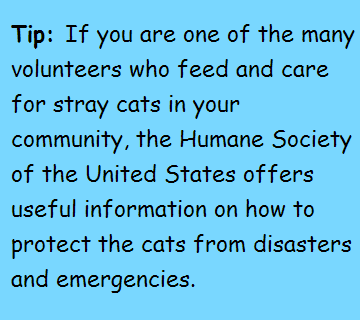Pet Care During and After a Disaster
We maintain a scheduled list of articles and information to post on this website. An article about preparing for pet care during and following disasters and emergencies has been on the list for several months. I consider the information especially important as I do other pet care posts but for some reason I didn't feel a sense of urgency about posting it. Real life changes the schedule instantly. For example, the posts on canine influenza moved to the top of the schedule a few months ago when dog flu became a sudden reality in my city.
A while back we posted a couple of links to expert advice about dealing with emergencies on our resource pages, we put an article about this subject on the schedule as a future post and that was that.
Then came Hurricane Harvey. The people and animals in Texas suffering during the storm and the aftermath, the relentless flooding, the fatalities, the injuries - and more and more rain and flooding - it all troubles me so. I can't get the people and their pets off my mind.
 In so many situations people simply do not have the financial means to up and go at the word of a meteorologist. Furthermore, like with Hurricane Harvey in Texas, forecasters knew Houston would flood but just exactly where does 2.3 million people evacuate to and how would that many people get out of the city at once. It would be pure chaos and as one official noted, chances are many would have drowned in traffic jams.
In so many situations people simply do not have the financial means to up and go at the word of a meteorologist. Furthermore, like with Hurricane Harvey in Texas, forecasters knew Houston would flood but just exactly where does 2.3 million people evacuate to and how would that many people get out of the city at once. It would be pure chaos and as one official noted, chances are many would have drowned in traffic jams.
Following Hurricane Katrina in 2005, it was noted that almost half of the residents who decided to stay and ride out the storm did so because they didn't want to leave pets behind. They had nowhere to go that would accommodate the animals. It makes me wonder if the same will be said of the catastrophe caused by Hurricane Harvey.
I dread reading the final numbers on fatalities after the door-to-door checks are completed, knowing each number represents a unique life. Of course, we'll never know how many pets lost their lives in this catastrophe. I remember following Hurricane Katrina, the numbers on dead animals was all over the place. For example, in 2015, CNN estimated that approximately 60,000 to 70,000 animals died as a result of Katrina. However, The Atlantic, a publication known for its credibility, published an article in 2012, seven years after Katrina, which cited the number of animals killed or stranded as being closer to 600,000. Yes, I got the zeros right - six hundred thousand!! Heartbreaking.
Making a Customized Plan
So what can we do to prevent a disaster from harming our pets?
Reading through the recommendations of several organizations experienced in making preparations for your pets before disaster strikes, I saw one thing over and over -- plan ahead, plan ahead, plan ahead. This was repeated in all the resources and references I went through, seven I think.
As most adults know, when disaster strikes, oftentimes making a split-second decision is not easy and does not always turn out as we would wish. If we know beforehand what we're going to do, when we're going to do it and how we're going to carry it out, things will likely go much smoother and the stress will be greatly reduced.
First of all we have to be aware of what disasters may strike in our area. Once we recognize what we need to prepare for, then we can make specific plans to deal with the situation.
Using my own situation as an example, my hometown, Frankfort, Kentucky is located far enough away from the coasts that hurricanes are not a threat. However, the Kentucky River meanders back and forth and around and about throughout my town. Historic floods have occurred in this area and likely will do so again in the future.
In addition, tornados are certainly a threat in my area. Thankfully, the weather service typically offers enough warning so that we have a chance to shelter. But I must think about plans for my animals if my residence is destroyed in a tornado. Where will I go? Where will my animals go? And how can I make arrangements so that if something should happen, we can all go together?
I've given this thought before and if necessary, I'm willing to pitch a couple of tents somewhere to be with my dogs. I can also learn useful information from experts who have been there and use this to my advantage.
 The U.S. Department of Homeland Security has an official website located at Ready.gov that offers tips on preparing for different types of disasters. Information includes helpful tips and advice on preparations for earthquakes, floods, hurricanes, power outages, tornados and other extreme severe weather conditions and much more. For example, if you live in an area prone to wildfires or an area near a volcano, this information is compartmentalized for those specific types of disasters.
The U.S. Department of Homeland Security has an official website located at Ready.gov that offers tips on preparing for different types of disasters. Information includes helpful tips and advice on preparations for earthquakes, floods, hurricanes, power outages, tornados and other extreme severe weather conditions and much more. For example, if you live in an area prone to wildfires or an area near a volcano, this information is compartmentalized for those specific types of disasters.
Preparations for all Types of Emergencies
Some preparations we need to make regardless of what type of emergency we may face in the future includes compiling pertinent information about our pets and writing it down.
Complete a pet emergency information sheet on your pets. This comes in handy in multiple situations. Carry it in your wallet and in the event of a disaster or emergency, the contact numbers needed for your pet will be on hand. We offer blank copies on our website, you can download a printable version free, print it, fill in the information and you'll have that much completed. (If you don't have access to a printer, send an email to questions@barbaraspetcareservices.com requesting a copy and provide your mailing address. We'll send you a blank form via the U.S. Postal Services at no charge to you.)
Remember if you have to go to a shelter, your pets may not be allowed to go with you. For example, shelters set up by the Red Cross accommodate only service animals and will not accept pets.
Therefore, you need to make arrangements before disaster strikes about where your animals can go and who will look after them.
This is not an easy task to complete. One reason is because, I know in my situation, many of the people I trust to look after my animals in the event of an emergency live in Frankfort. Therefore, if something devastated my city, my friends and some of my family members would be dealing with the same disaster. That's why organizations that are experienced in dealing with emergencies recommend writing down contact information for someone that could take your pets out of the city or area in which you live.
In addition, on our website is a disaster preparation checklist, "Preparing Your Pets for Emergencies." You can print this and use it to make preparations now before disaster strikes. This information is offered by FEMA, compiled in conjunction with the American Veterinary Medical Association, the ASPCA, the AKC, The Humane Society of the United States and the U.S. Department of Homeland Security. It provides a thorough list of things we can gather now and have on hand if needed, as well as information on how to set up and execute an emergency plan.
References:
American Animal Hospital Association
American Red Cross
CNN: The Forgotten Victims of Disaster
Ready.gov (U.S. Department of Homeland Security): Be Informed
The Atlantic: 7 Years After Katrina, New Orleans is Overrun by Wild Dogs
Additional Resource:
The Humane Society of the United States: Make a Disaster Plan for Your Pets
